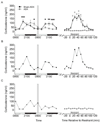Role of the dorsomedial hypothalamus in glucocorticoid-mediated feedback inhibition of the hypothalamic-pituitary-adrenal axis
- PMID: 25556980
- PMCID: PMC4367871
- DOI: 10.3109/10253890.2015.1004537
Role of the dorsomedial hypothalamus in glucocorticoid-mediated feedback inhibition of the hypothalamic-pituitary-adrenal axis
Abstract
Previous studies suggest that multiple corticolimbic and hypothalamic structures are involved in glucocorticoid-mediated feedback inhibition of the hypothalamic-pituitary-adrenal (HPA) axis, including the dorsomedial hypothalamus (DMH), but a potential role of the DMH has not been directly tested. To investigate the role of the DMH in glucocorticoid-mediated negative feedback, adult male Sprague Dawley rats were implanted with jugular cannulae and bilateral guide cannulae directed at the DMH, and finally were either adrenalectomized (ADX) or were subjected to sham-ADX. ADX rats received corticosterone (CORT) replacement in the drinking water (25 μg/mL), which, based on initial studies, restored a rhythm of plasma CORT concentrations in ADX rats that was similar in period and amplitude to the diurnal rhythm of plasma CORT concentrations in sham-ADX rats, but with a significant phase delay. Following recovery from surgery, rats received microinjections of either CORT (10 ng, 0.5 μL, 0.25 μL/min, per side) or vehicle (aCSF containing 0.2% EtOH), bilaterally, directly into the DMH, prior to a 40-min period of restraint stress. In sham-ADX rats, bilateral intra-DMH microinjections of CORT, relative to bilateral intra-DMH microinjections of vehicle, decreased restraint stress-induced elevation of endogenous plasma CORT concentrations 60 min after the onset of intra-DMH injections. Intra-DMH CORT decreased the overall area under the curve for plasma CORT concentrations during the intermediate time frame of glucocorticoid negative feedback, from 0.5 to 2 h following injection. These data are consistent with the hypothesis that the DMH is involved in feedback inhibition of HPA axis activity at the intermediate time frame.
Keywords: 5-HT1A; HPA axis; automated blood sampling; corticosterone; dorsomedial hypothalamus; negative feedback; serotonin.
Figures





Similar articles
-
Activation of 5-HT1A receptors in the rat dorsomedial hypothalamus inhibits stress-induced activation of the hypothalamic-pituitary-adrenal axis.Stress. 2017 Mar;20(2):223-230. doi: 10.1080/10253890.2017.1301426. Epub 2017 Mar 27. Stress. 2017. PMID: 28345385
-
Effects of prenatal ethanol exposure on hypothalamic-pituitary-adrenal regulation after adrenalectomy and corticosterone replacement.Alcohol Clin Exp Res. 2001 Jun;25(6):890-7. Alcohol Clin Exp Res. 2001. PMID: 11410726
-
Glucocorticoid Fast Feedback Inhibition of Stress-Induced ACTH Secretion in the Male Rat: Rate Independence and Stress-State Resistance.Endocrinology. 2016 Jul;157(7):2785-98. doi: 10.1210/en.2016-1123. Epub 2016 May 4. Endocrinology. 2016. PMID: 27145013 Free PMC article.
-
Role of glucocorticoid negative feedback in the regulation of HPA axis pulsatility.Stress. 2018 Sep;21(5):403-416. doi: 10.1080/10253890.2018.1470238. Epub 2018 May 15. Stress. 2018. PMID: 29764284 Free PMC article. Review.
-
Hypothalamic-pituitary-adrenal axis activity in post-traumatic stress disorder and cocaine use disorder.Stress. 2020 Nov;23(6):638-650. doi: 10.1080/10253890.2020.1803824. Epub 2020 Aug 24. Stress. 2020. PMID: 32835581 Review.
Cited by
-
Organic cation transporter 3: A cellular mechanism underlying rapid, non-genomic glucocorticoid regulation of monoaminergic neurotransmission, physiology, and behavior.Horm Behav. 2018 Aug;104:173-182. doi: 10.1016/j.yhbeh.2018.05.003. Epub 2018 May 10. Horm Behav. 2018. PMID: 29738736 Free PMC article. Review.
-
Stereotaxic surgery for implantation of guide cannulas for microinjection into the dorsomedial hypothalamus in young rats.MethodsX. 2019 Jul 8;6:1652-1659. doi: 10.1016/j.mex.2019.07.005. eCollection 2019. MethodsX. 2019. PMID: 31372353 Free PMC article.
-
Postsynaptic Depolarization Enhances GABA Drive to Dorsomedial Hypothalamic Neurons through Somatodendritic Cholecystokinin Release.J Neurosci. 2015 Sep 23;35(38):13160-70. doi: 10.1523/JNEUROSCI.3123-14.2015. J Neurosci. 2015. PMID: 26400945 Free PMC article.
-
Phase-shifting the circadian glucocorticoid profile induces disordered feeding behaviour by dysregulating hypothalamic neuropeptide gene expression.Commun Biol. 2023 Sep 29;6(1):998. doi: 10.1038/s42003-023-05347-3. Commun Biol. 2023. PMID: 37775688 Free PMC article.
-
A users guide to HPA axis research.Physiol Behav. 2017 Sep 1;178:43-65. doi: 10.1016/j.physbeh.2016.11.014. Epub 2016 Nov 18. Physiol Behav. 2017. PMID: 27871862 Free PMC article. Review.
References
-
- Anseloni VC, He F, Novikova SI, Turnbach RM, Lidow IA, Ennis M, Lidow MS. Alterations in stress-associated behaviors and neurochemical markers in adult rats after neonatal short-lasting local inflammatory insult. Neuroscience. 2005;131:635–645. - PubMed
-
- Bailey TW, DiMicco JA. Chemical stimulation of the dorsomedial hypothalamus elevates plasma ACTH in conscious rats. Am J Physiol Regul Integr Comp Physiol. 2001;280:R8–R15. - PubMed
-
- Bernardis LL, Bellinger LL. The dorsomedial hypothalamic nucleus revisited: 1998 update. Proc Soc Exp Biol Med. 1998;218:284–306. - PubMed
-
- Cnaan A, Laird NM, Slasor P. Using the general linear mixed model to analyse unbalanced repeated measures and longitudinal data. Stat Med. 1997;16:2349–2380. - PubMed
Publication types
MeSH terms
Substances
Grants and funding
LinkOut - more resources
Full Text Sources
Other Literature Sources
Medical
